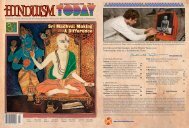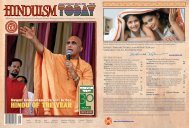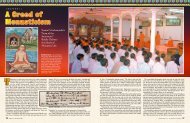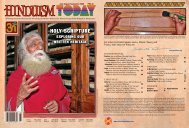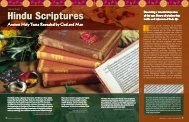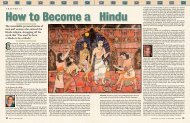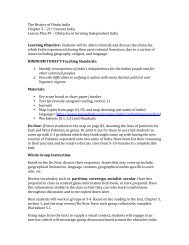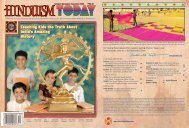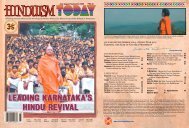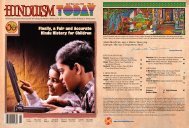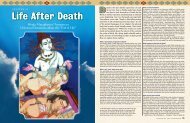Hinduism Today July 2007 - Cover, Index, Gatefold, Front Articles
Hinduism Today July 2007 - Cover, Index, Gatefold, Front Articles
Hinduism Today July 2007 - Cover, Index, Gatefold, Front Articles
Create successful ePaper yourself
Turn your PDF publications into a flip-book with our unique Google optimized e-Paper software.
Hindu History Lesson<br />
hinduism today’s 16-page hindu history<br />
lesson (“<strong>Hinduism</strong> from Ancient<br />
Times,” Apr/May/Jun, <strong>2007</strong>) is both correct<br />
and authentic, and definitely better than<br />
I have seen in any school textbook. The<br />
<strong>Hinduism</strong> <strong>Today</strong> editorial staff deserves<br />
our sincere appreciation and gratitude for<br />
producing this positive and constructive<br />
account for sixth grade students anywhere<br />
in the world. In fact, if each Hindu were<br />
to learn and remember this narrative, the<br />
Hindu community would be better off in<br />
this increasingly pluralistic society. The crucial<br />
problem with Hindus has been our inability<br />
to succinctly describe <strong>Hinduism</strong> as a<br />
whole, or even to briefly explain it properly.<br />
<strong>Hinduism</strong> <strong>Today</strong>’s narrative will go a long<br />
way in redressing this prevailing disability. I<br />
endorse it wholeheartedly and without reservations.<br />
It should be required reading for<br />
every Hindu.<br />
Shiva G. Bajpai, Ph.D<br />
Director, Center for Asian<br />
Studies, California State<br />
University, Northridge, CA, USA<br />
∫ hchis006@csun.edu<br />
coming from an organization which<br />
practices, teaches and spreads the message<br />
of the most ancient but most adoptive Hindu<br />
faith, naturally this lesson is well written,<br />
factual and clear in presentation for preteens<br />
to understand, learn and enjoy. Reading<br />
this material not only makes any Hindu<br />
child proud of his/her heritage, but it also<br />
gives the right facts on one of the major religions<br />
in the world. I strongly recommend<br />
“<strong>Hinduism</strong> from Ancient Times” as teaching<br />
material on <strong>Hinduism</strong> for ten-year-olds in<br />
schools in all states.<br />
G.V. Raghu, M.D.<br />
President, Chinmaya Mission of Atlanta;<br />
Former Chairman, Education Committee,<br />
Hindu Temple of Atlanta, GA, USA<br />
this is a very clear introduction to<br />
<strong>Hinduism</strong>. It is in line with the requirements<br />
of a history lesson and yet manages<br />
to put across some of the more subtle ideas<br />
inherent in <strong>Hinduism</strong> in an eloquent and<br />
effective manner. The lesson allows us to<br />
picture life in ancient times and manages<br />
to interweave history with the key beliefs<br />
and practices of <strong>Hinduism</strong>. The correct<br />
historic perspective on the development of<br />
<strong>Hinduism</strong> is useful, as it allows <strong>Hinduism</strong> to<br />
take a lead role in directing how spirituality<br />
unfolds on the contemporary scene. Congratulations<br />
for publishing such a wonderful<br />
article to address the needs of Hindu youth<br />
in the West.<br />
Jay Lakhani<br />
Vivekananda Centre, London, UK<br />
letters<br />
the supplement prepared by hinduism<br />
<strong>Today</strong> for sixth grade students is a most<br />
valuable and worthwhile publication. It<br />
provides a simple and concise summary of<br />
<strong>Hinduism</strong> that is both correct and authentic.<br />
It is definitely better than any sixth grade<br />
school textbook portrayal of <strong>Hinduism</strong> currently<br />
in use in the USA.<br />
Ved Prakash Chaudhary, Ph.D<br />
President, Educators Society for the<br />
Heritage of India, Morganville, NJ, USA<br />
for too long, school children beginning<br />
their first encounter with the most<br />
ancient of living religious traditions in the<br />
world have been subjected to inaccurate,<br />
incomplete and simplistic depictions of<br />
<strong>Hinduism</strong>. Presenting <strong>Hinduism</strong> from the<br />
perspective of its practitioners to those who<br />
are being introduced to it for the first time<br />
seems a simple enough concept. Yet, too<br />
many Hindu children to date have faced a<br />
perplexing disconnect as the religion they<br />
read about in school bears no resemblance<br />
to that which they practice at home. In contrast,<br />
Christian, Jewish and Muslim children<br />
do not face such a lack of association about<br />
their faith. With this document, the publishers<br />
of <strong>Hinduism</strong> <strong>Today</strong> fill a critical void in<br />
the educational syllabus for Hindu and non-<br />
Hindu students alike. <strong>Hinduism</strong> <strong>Today</strong> is<br />
recognized globally as the premier periodical<br />
documenting the experience of the Hindu<br />
community worldwide. Celebrated for its<br />
commitment to accuracy and professionalism,<br />
<strong>Hinduism</strong> <strong>Today</strong> has once again applied<br />
its high standards of rigorous editing<br />
and artistry to this latest production. While<br />
no document can possibly encompass fully<br />
the breadth, complexity and plurality of Hindu<br />
practice and belief, the Hindu American<br />
Foundation finds that “<strong>Hinduism</strong> from Ancient<br />
Times” compromises little in describing<br />
the universal ideals of <strong>Hinduism</strong> that<br />
have emerged from its wondrous diversity.<br />
Hindu American Foundation<br />
Kensington, MD, USA<br />
on behalf of the hindu swayamsevak<br />
Sangh (HSS), I express our heartfelt congratulations<br />
and deep gratitude to the entire<br />
staff of <strong>Hinduism</strong> <strong>Today</strong> for the Hindu<br />
history lesson. Your “response to the controversy<br />
in California over the way <strong>Hinduism</strong><br />
is taught in public-school history books” is<br />
timely and compelling, and you have articulated<br />
the message so thoughtfully and<br />
eloquently. On difficult or controversial issues,<br />
such as the Aryan invasion theory, your<br />
simple statement that “all the evidence for<br />
it is questionable,” says it all so effectively.<br />
The lesson provides an exemplary guide to<br />
the student to understand Hindu beliefs and<br />
scriptures and to appreciate what <strong>Hinduism</strong><br />
in practice really means. It is indeed a significant<br />
contribution to creating awareness<br />
of <strong>Hinduism</strong> here in the West. Thank you<br />
for all that you do to spread Hindu wisdom.<br />
Dr. Ved Nanda<br />
President, Hindu Swayamsevak Sangh; Vice<br />
Provost, University of Denver, CO, USA<br />
hinduism today has performed an<br />
important public service by providing a<br />
clear and accessible text which presents<br />
<strong>Hinduism</strong> from a Hindu perspective. This<br />
presentation provides a needed counterbalance<br />
to textbooks on <strong>Hinduism</strong> which<br />
are sometimes inaccurate or fail to give a<br />
perspective that would be recognizable to<br />
most Hindus, and which emphasize negatives<br />
such as untouchability, a practice to<br />
which many Hindus object. And yet it does<br />
so in a way which does not whitewash or<br />
ignore the problematic nature of caste. The<br />
particular strength of <strong>Hinduism</strong> <strong>Today</strong>’s<br />
presentation is that not only does it not<br />
give a monolithic depiction of <strong>Hinduism</strong>,<br />
it distinguishes among the various Hindu<br />
traditions—Vaishnava, Saiva, Shakta and<br />
Smarta—with a degree of detail not typically<br />
found in basic introductions to <strong>Hinduism</strong>.<br />
Though designed for sixth-graders, I<br />
could imagine myself recommending these<br />
sections as review material for my college<br />
students. The section on the origins of<br />
<strong>Hinduism</strong> is likely to be the most controversial,<br />
given the ongoing debates about the<br />
Aryan migration theory. But I like the way<br />
this presentation emphasizes areas in which<br />
our knowledge is still lacking, rather than<br />
strongly affirming a counter-theory of indigenous<br />
Aryan origins as a Hindu nationalist<br />
history would do. All in all, excellent work!<br />
I am happy to endorse this presentation of<br />
<strong>Hinduism</strong>.<br />
Jeffery D. Long, Ph.D.<br />
Chair, Department of Religious<br />
Studies, Elizabethtown College,<br />
Elizabethtown, PA, USA<br />
we are deeply grateful to hinduism<br />
<strong>Today</strong> for its extraordinary work in presenting<br />
<strong>Hinduism</strong> in its appropriate historical<br />
light, with tangible facts gleaned from Hindu<br />
experts and scholars to support and broadcast<br />
the intrinsic values of the Hindu tradition.<br />
It is distressing to see <strong>Hinduism</strong>’s vast<br />
history belittled and whittled down by the<br />
hands of those whose personal agendas are<br />
ambitious and prejudiced, evidenced by the<br />
inured spate of fictitious theories, such as the<br />
Aryan Invasion/Migration theory once more<br />
being resurrected by Western Indologists,<br />
Christian theologians and academicians. Unlike<br />
any other spiritual tradition in America,<br />
with the inalienable right to have their culture<br />
portrayed accurately, Hindu academicians<br />
and scholars are given far less berth<br />
to rectify erroneous information about their<br />
culture. It is a breath of fresh air to see this<br />
ancient culture of harmony and nonviolence<br />
portrayed in accurate light, rather than witness<br />
more of the general bias perpetrated for<br />
too many centuries against it.<br />
As we begin to address the disparaging<br />
light to which <strong>Hinduism</strong> is subjected by the<br />
many misinformed and misguided, we must<br />
all take part in undoing, rectifying and healing<br />
the crimes of the past. Specifically, let<br />
us not turn our backs on the humongous dilemma<br />
now pandemic within Hindu culture:<br />
the caste system. Apparently, this system is<br />
securely tied to the intricately engineered<br />
political missile programmed to perennially<br />
generate and inflict hurt, damage and destruction<br />
on <strong>Hinduism</strong>.<br />
Factions against <strong>Hinduism</strong> can be found in<br />
many shapes and forms: among India’s politicians<br />
and religious leaders, European historians<br />
and “experts” (who write their own<br />
version of <strong>Hinduism</strong>’s history), and Western<br />
Indologists and academicians—all motivated<br />
by one or the other ingredient of the illusionary<br />
mix of power, fame, wealth, race and<br />
prejudice.<br />
Whatever is the motivation for the ongoing<br />
epidemic of misinformation, we have got<br />
to dig deep within ourselves to find the collective<br />
solution. To do so, we must come to<br />
terms with the most pertinent question of<br />
our time: How did <strong>Hinduism</strong> come to find<br />
itself mired in the irreverent and inhumane<br />
state that is the caste system?<br />
The greatest contributor to the hurt and<br />
confusion within <strong>Hinduism</strong> is the perversion<br />
of its harmonious community concept<br />
of varnas, which refers to our inner divinity,<br />
the light of consciousness. A primary meaning<br />
of the word varna is “luster; light of<br />
dawn,” which reveals the core intention of<br />
the varna community constitution that has<br />
been erroneously and deviously retooled as<br />
the “caste system.” This retooling was deliberately<br />
performed by the endless foreign<br />
invaders and incursions upon the body and<br />
spirit of <strong>Hinduism</strong>. These incursions served<br />
to seal the fate of the perverted caste system<br />
within India. But as the Hindu people<br />
know, the karma of fate is never sealed. In<br />
this case, it can and must be changed.<br />
Sri Swamini Mayatitananda<br />
Spiritual Head, Wise Earth Monastery<br />
Candler, NC, USA<br />
the lesson on hinduism presents a<br />
lucid, authentic and easily-understandable<br />
picture of Hindu history, tradition and<br />
practices. I hear so many complaints from<br />
Hindu parents and students in the USA<br />
and Europe regarding the incorrect, and<br />
even frequently demeaning, presentation<br />
of <strong>Hinduism</strong> in world religions classes. It is<br />
time that the educational boards and textbook<br />
publishers take a sincere interest in<br />
presenting <strong>Hinduism</strong> in a factual manner.<br />
This is the most comprehensive summary<br />
of <strong>Hinduism</strong>’s multi-faceted tradition that I<br />
have seen to date. I wholeheartedly and unequivocally<br />
recommend its use in all official<br />
textbooks for students.<br />
Swami Chidanand Saraswati<br />
Founder and Chairman, India Heritage<br />
Research Foundation, Rishikesh, India<br />
i have been aware for some years of<br />
the poor presentation of <strong>Hinduism</strong> in our<br />
public schools. Both parents and children<br />
have complained to me about it. The Hindu<br />
religion is inadequately explained, and in unflattering<br />
terms in the elementary and middle<br />
school social studies and history books.<br />
In many places, we notice mutilation of facts<br />
about <strong>Hinduism</strong>, and often these are getting<br />
quoted. I congratulate <strong>Hinduism</strong> <strong>Today</strong> for<br />
addressing this situation with its sixth-grade<br />
history lesson in <strong>Hinduism</strong>. This lesson corrects<br />
many of the errors in the current chapters<br />
on <strong>Hinduism</strong>, presents the religion in a<br />
sympathetic light and describes the religion<br />
in the way Hindus understand and practice<br />
it. The lesson is a commendable attempt to<br />
produce a simple history of <strong>Hinduism</strong> that<br />
is acceptable to nearly all in our religion.<br />
C.K. Hiranya Gowda, M.D.<br />
Former President, Hindu Temple<br />
of Nashville, TN, USA<br />
Greatness of <strong>Hinduism</strong><br />
thank you for gurudeva’s most profound<br />
and enlightening article (“<strong>Hinduism</strong>,<br />
the Greatest Religion in the World,” Oct/<br />
Nov/Dec, 2006). I was not only moved by<br />
his home truths, but his divine greatness<br />
is apparent in the lofty philosophy which<br />
leaves Sanatana Dharma without any peer<br />
and, I must add, the only true living religion<br />
that will survive for all time. I am also mindful<br />
of the oft quoted saying, “What you cannot<br />
find in <strong>Hinduism</strong>, you will find nowhere<br />
else.” The quest for a perfect life for every<br />
Hindu is intrinsically interwoven in the law<br />
of karma, which can be easily interpreted in<br />
the quotation, “All the good deeds of a lifetime<br />
are washed away in the flood caused<br />
by a single sin.” The relentless pursuit to<br />
transform into the most perfect and eventually<br />
liberated soul harkens every Hindu on<br />
his spiritual journey back to God.<br />
Loggienathan Naidoo<br />
Durban, South Africa<br />
∫ logie@polka.co.za<br />
An Eye for an Eye<br />
i saw the phrase “an eye for an eye”<br />
used in the Letters section and “<strong>Hinduism</strong><br />
and Modern Life” in the Apr/May/Jun,<br />
<strong>2007</strong>, issue. I am a Jewish woman who regularly<br />
reads and enjoys your magazine, and I<br />
would like to give your readers some background<br />
on that often misused and misunderstood<br />
phrase. It comes from the Jewish<br />
Torah, which is also the first five books of<br />
the Christian Bible, specifically from three<br />
different places: Exodus 21:24, Leviticus<br />
24:20 and Deuteronomy 19:21. This phrase<br />
does not mean that one should exact revenge<br />
for a wrong. It does mean that restitution<br />
should be just and fair. If someone<br />
causes another person harm, be it physical<br />
or monetary, he should only be responsible<br />
for returning the value of what was harmed.<br />
Prior to this concept, a man might take another<br />
man’s life as revenge for a broken arm,<br />
for example. Justice is very important in the<br />
Jewish faith. The concept of “an eye for an<br />
eye, a tooth for a tooth” was designed to protect<br />
both the rich and the poor, the weak<br />
and the strong.<br />
Jennifer Plunk<br />
Ellerslie, GA, USA<br />
∫ jplunk@bellsouth.net<br />
Corrections<br />
✔ In Diaspora, “Wiccan Wife Wins Cause,”<br />
Apr/May/Jun, <strong>2007</strong>, it was indicated that officials<br />
approved the pentacle’s placement on<br />
Sgt. Stewart’s grave marker after his wife<br />
threatened a lawsuit. The grave marker in<br />
fact does display the Wiccan pentacle, but<br />
its presence is due to the memorial site’s being<br />
state-owned, not under the authority of<br />
the VA, and Nevada’s having deemed the<br />
pentacle an acceptable faith symbol. Additionally,<br />
in a settlement with Americans<br />
United for Separation of Church and State<br />
on April 23, <strong>2007</strong>, the VA finally approved<br />
the Wiccan pentacle symbol for deceased<br />
veterans’ grave markers in VA cemetaries.<br />
✔ In “Canada’s Hindu Youth,” Apr/May/<br />
Jun, <strong>2007</strong>, the interviewees are from the<br />
Hindu Temple in Richmond Hill, not the<br />
Varasiddhi Vinayagar Temple; the correct<br />
website address is www.thehindutemple.ca;<br />
the photo of Sivakami Loganathan appears<br />
on page 53, not page 61, and the musical<br />
teacher’s name is Bhuma Krishnan, not<br />
Uma Krishnan.<br />
✔ The number of saints who authored the<br />
Panniru-Thirumurai is given as as 64 in “In<br />
Praise of Siva’s Singers,” Apr/May/Jun, <strong>2007</strong>.<br />
The correct number is 27. Photos in the article<br />
are by the author, Anantha Krishnan.<br />
Letters with writer’s name, address and daytime<br />
phone number should be sent to:<br />
Letters, <strong>Hinduism</strong> <strong>Today</strong><br />
107 Kaholalele Road<br />
Kapaa, Hawaii, 96746-9304 USA<br />
or faxed to: (808) 822-4351<br />
or e-mailed to: letters@hindu.org<br />
Letters may be edited for space and clarity and may<br />
appear in electronic versions of <strong>Hinduism</strong> <strong>Today</strong>.<br />
∫ indicates letters received via e-mail<br />
12 hinduism today july/august/september, <strong>2007</strong><br />
july/august/september, <strong>2007</strong> h i n d u i s m t o d ay 13



